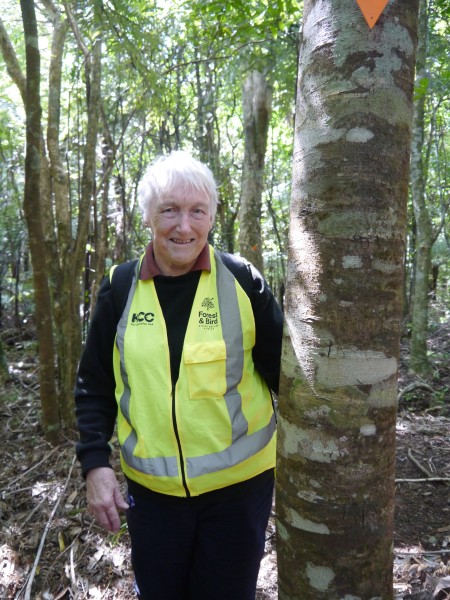Members of our Te Puke Branch left a huge legacy for kōkako conservation when they fought to protect Rotoehu Forest 35 years ago. By Caroline Wood
Forest & Bird magazine
A version of this story was first published in the Summer 2023 issue of Forest & Bird magazine.

A Bay of Plenty forest saved from being milled in the late 1980s is now home to Aotearoa New Zealand’s secondlargest mainland population of kōkako, with numbers skyrocketing 89% in four years.
A recent survey of the Rotoehu Forest, between Rotorua, Whakatāne, and Te Puke, found kōkako numbers had risen to 289 pairs, up from 157 pairs in 2019.
The Rotoehu Ecological Trust, which has managed bait stations in the forest since 2013, says the survey result is testament to the hard work of community volunteers and advocates who have strived for decades to protect the forest.
“We pay tribute to all who have gone before us in creating and maintaining the safe spaces in which this kōkako population has thrived,” says trustee Jane Bird.
“In the late 1980s, protests by members of Te Puke Forest & Bird led to the creation of a protected conservation and ecological area, which was home to the ancestors of the current kōkako population.
“Since that time, many organisations have supported the population, and Rotoehu Ecological Trust/Kōkako Ecosanctuary is very fortunate to be assisting DOC with management of what is now a rapidly expanding kōkako population.”
Today, the Pongakawa Ecological Area, a bush block north of Lake Rotoehu, is an ecological reserve of public conservation land managed by the Rotorua Department of Conservation Office.
But from the 1940s to 1970s, it was subject to native logging, and Te Puke Forest & Bird was instrumental in getting the area set aside for conservation purposes.
They decided to act after North Island kōkako were found to live there during the 1980s.

Carole Long. Credit Caroline Wood
Forest & Bird’s Distinguished Life Member Carole Long, who won a Queen’s Service Medal for a lifetime of services to conservation, remembers the fight for Rotoehu Forest, one of many waged by Forest & Bird in the late 1980s.
“Rotoehu forest was home to kōkako, and we had already had a battle to keep logging trucks off Tawa Road [near Rotorua],” she said.
“Another challenge was the Forest Service’s decision to do logging and plant Tasmanian blackwood trees in the kōkako reserve – that was the start of conservation activism!
“I was part of a group of totally law-abiding citizens who went through those sites and ripped out blackwood seedlings by the dozen. It saved the Department of Conservation a job later on. We also succeeded in getting good land allocation to DOC, with corridors for kōkako to move between habitat sites.”
North Island kōkako are a blue-wattled ancient endemic species with a beautiful haunting call. Today, the largest mainland population is at Pureora Forest (more than 600 pairs), followed by Rotoehu Forest (289 pairs) and the Hunua Ranges (more than 250 pairs).
Te Hauturu-o-Toi Little Barrier Island also hosts a large population of more than 400 pairs. The Rotoehu population has benefited from ongoing and longterm efforts to control introduced predators on 2450ha of public conservation land using bait stations and aerially applied 1080 bait pellets.
Ngāti Makino Iwi Authority is working alongside DOC to help protect kōkako and other native species at Rotoehu Forest. Kōkako hold a special place in the stories and traditional knowledge of the area.
“Preserving our native kōkako species is deeply rooted in our cultural and spiritual connection to the land and its environment,” says John Rapana, Ngāti Mākino Tribal Authority Environmental Manager.
“Over the centuries, observation of our kōkako and other manu taonga species resulted in an accumulation of local knowledge Rotoehu Forest. Rotoehu Ecological Trust about their behaviour, habitat, and seasonal patterns that were observed, contextualised, and appropriated into our cultural stories and practices.
“From an iwi perspective, we are obligated to maintain our poutiaki role with our environment and its inhabitants. We must continue to develop multiple skill sets for our people to be confident and competent to undertake specialised roles to support our manu taonga and its environment.”

Rotoehu Forest. Credit Rotoehu Ecological Trust
This year's kōkako survey was organised by Rotoehu Ecological Trust and undertaken by Dave Bryden, Amanda Rogers, and a team of five. Rotoehu Ecological Trust sought the funding for the survey, which was provided by Bay of Plenty Regional Council, Wai Kokopu, Bay Trust and Kaingaroa Timberlands.
DOC will continue to use aerially applied 1080 bait in combination with a ground control programme led by the local community to help kōkako and other native species breed.
Other forest locals include titipounamu riflemen, kererū, korimako bellbird, pōpokatea whitehead, toutouwai North Island robin, tūī, ruru morepork, and pekapeka bats.

